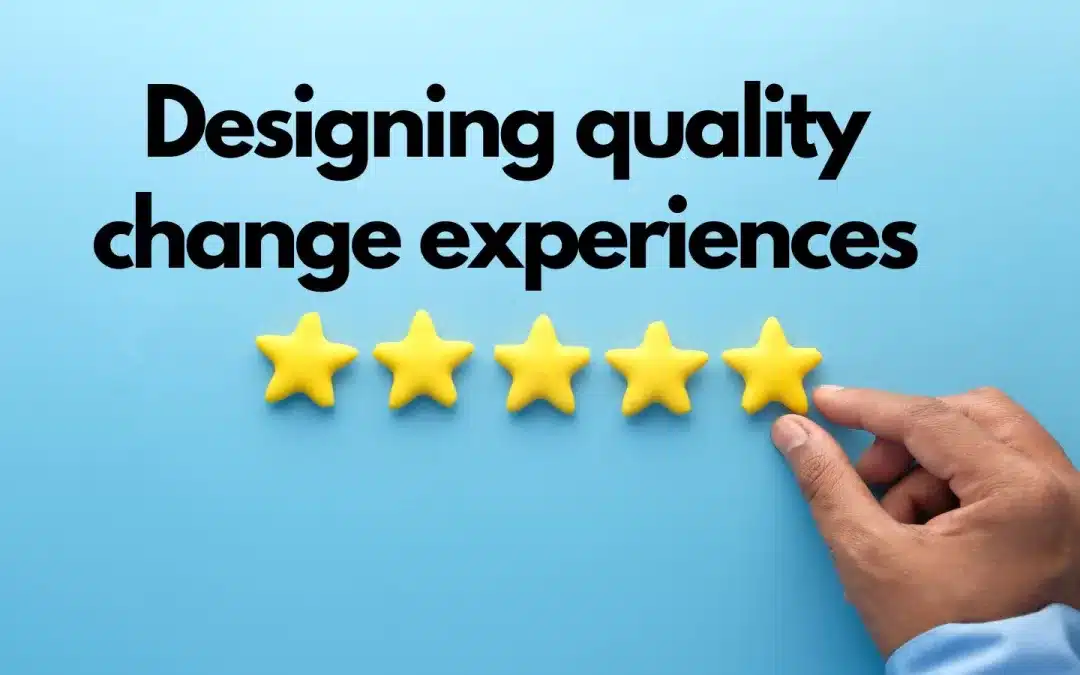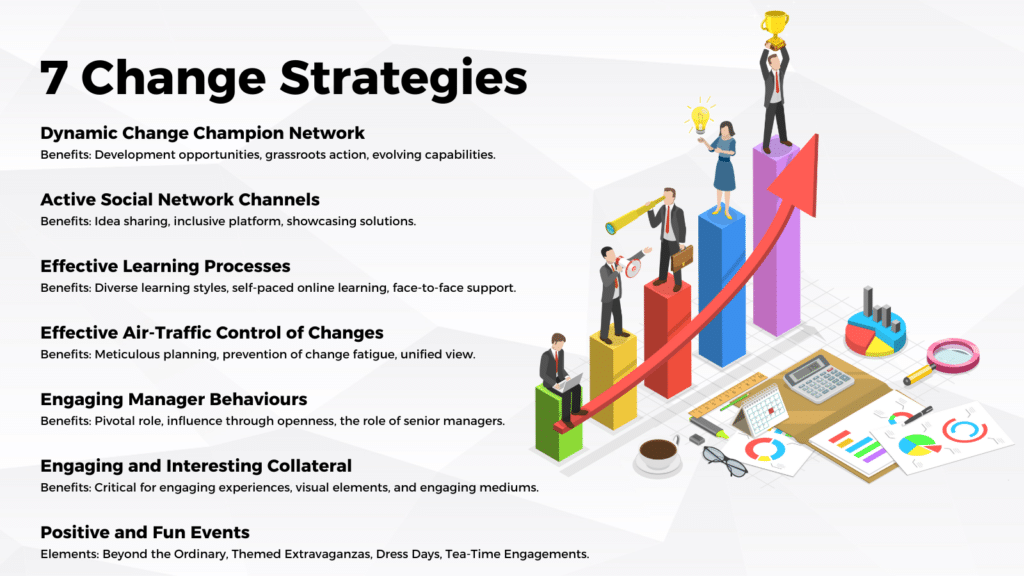
Designing quality change experiences
Successfully achieving business outcomes through change requires good people change experiences. A positive employee change experience means that he/she is more likely to be engaged and more able to deliver a great customer experience.
How does one go about designing and crafting this experience? To achieve accolades in people’s experience, one needs to think broadly about a range of experiences. This could involve anything ranging from manager discussions, online discussions, avenues for peer conversations, senior leadership behavior, and supporting collateral.
Designing a great change experience for employees working in an organization is no different than designing a great quality of life for dwellers living in a particular city. A city needs to focus on having a vibrant economy, a happening retail scene, good access to parks and nature, great transportation links, and developed sports and arts scenes. All of these contribute to the quality of life of those who call the city home. In a similar way, in organizations, it involves a broad spectrum of experiences, including manager discussions, online forums, peer conversations, senior leadership behavior, and supporting collateral.
There are foundational ways of engaging with employees during change that apply to all organizations, such as manager-employee conversations, authenticity, clarity of the message, and involvement in the change process. On the other hand, progressive ways to engage with employees using technology can also contribute to making a great change experience. In this article, we will delve into seven key strategies to design exceptional employee experiences during times of change, encompassing both foundational and progressive approaches.

- A dynamic change champion network supporting various change initiatives.
A robust and well-organized change champion network stands as the linchpin for successful initiatives. This network not only provides valuable developmental opportunities for employees but also functions as a vibrant hub for grassroots action, propelling organizational change. In this collaborative space, employees share innovative ideas, collaborate on preparing their teams for change, and play a pivotal role in disseminating critical information.
Change champions serve as passionate advocates, internalizing the responsibility to articulate the envisioned end state of the change to their colleagues. Going beyond advocacy, they actively gather frontline feedback, ensuring upper levels comprehend the concerns and insights of their peers. Moreover, change champions supporting the business across a spectrum of changes have the potential to evolve and enhance their capabilities over time, contributing significantly to the resilience and effectiveness of the entire change champion network.
Key Benefits of a Dynamic Change Champion Network
- Provides valuable development opportunities for employees.
- Drives organizational change through grassroots action.
- Change champions play a crucial role in internalizing accountability, sharing feedback, and supporting multiple changes.
- Active social network channels to discuss, share, and support one another during change.
Engaging employees during change is greatly facilitated by active social network channels. Platforms such as Yammer offer a powerful means to connect employees, encouraging idea-sharing and mutual support. While the use of social channels requires vigilant monitoring, the benefits far outweigh any potential drawbacks.
Digital channels provide an inclusive space where even those unable to attend town halls or hesitant to speak up in person can contribute and be heard. Numerous instances showcase employees leveraging these platforms to propose innovative solutions for addressing customer needs, cultivating a fertile ground for continuous improvement. Additionally, employees can share their experiences with the new system, posing questions and receiving assistance from their peers.
Key Benefits of Active Social Networks
- Facilitates idea sharing and mutual support.
- Inclusive platform for all employees, irrespective of their participation in town halls.
- Showcases real examples of innovative solutions and continuous improvement.
- Effective learning processes
Modern organizations recognize the importance of diverse learning approaches to achieve optimal outcomes. Acknowledging that employees have distinct learning styles, progressive organizations offer various options tailored to individual preferences.
Traditional face-to-face learning settings often leave some employees breezing through content, while others require additional clarification, support, and hands-on experience. To address these differences, self-paced online learning emerges as an effective solution, accommodating varying speeds of comprehension. Change champions play a vital role in this process, offering face-to-face support to those who benefit from a more personalized approach. Furthermore, organizations can create “sand-pits” or training environments, allowing employees to immerse themselves in the new system, process, or workflow before its official release. This hands-on experience ensures that employees feel confident and well-prepared for the impending change.
Key Benefits of Effective Learning Processes
- Recognizes diverse learning styles among employees.
- Self-paced online learning accommodates varying speeds of comprehension.
- Change champions provide personalized face-to-face support.
- “Sand-pits” or training environments offer hands-on experience prior to change implementation
- Effective air traffic control of changes to manage change capacity
A seamless change experience necessitates meticulous planning and coordination within the organizational landscape. Given that most employees contend with multiple changes simultaneously, strategic management of these initiatives becomes paramount.
Organizations must metaphorically act as air traffic controllers, ensuring that various changes do not “land” concurrently, overwhelming employees. Achieving this coordination requires a unified view of change impacts, enabling the careful design of employee experiences. Establishing dedicated forums and routines to review change impact data is crucial in making effective sequencing decisions.
This proactive approach not only prevents change fatigue but also enhances the overall employee experience. For a detailed exploration of change management strategies and managing multiple initiatives concurrently, delve into our comprehensive guide here.
Key Benefits of Effective Change Coordination
- Meticulous planning and coordination are essential for a seamless change experience.
- Employees often grapple with multiple changes simultaneously, necessitating strategic management.
- Organizations must act as air traffic controllers to prevent simultaneous “landings” of various changes.
- A unified view of change impacts enables the careful design of employee experiences.
- Dedicated forums and routines for reviewing change impact data facilitate effective sequencing decisions.
- Engaging manager behaviours throughout the change process
In the realm of change experiences, the behavior of managers stands as the linchpin of effectiveness. A manager’s openness, authenticity, and commitment to engaging in transparent conversations about change wield substantial influence over the employee’s change journey.
Managers who are absent, fail to conduct one-on-ones, withhold information, or disregard feedback contribute significantly to a negative change experience. Recognizing this, senior managers and formal sponsors of change bear a pivotal role. They are entrusted with not only selling the change vision but also igniting robust support and momentum throughout the organization, facilitating a seamless transition to the new state.
Key Benefits of Effective Managerial Engagement
- Managerial behavior is pivotal in shaping an effective change experience for employees.
- Openness, authenticity, and transparent communication from managers significantly influence the change journey.
- Ineffective managers, characterized by absence, lack of communication, and disregard for feedback, contribute to negative experiences.
- Senior managers and formal change sponsors play a crucial role in selling the change vision and fostering organizational support.
- Engaging and interesting collateral about the change
In the orchestration of change experiences, the role of change marketing emerges as a pivotal success criterion. The creation of engaging employee experiences hinges on the effective design of collateral that not only sends the right messages but also resonates through the appropriate channels.
To support the marketing process, collateral must be meticulously crafted, employing visual elements such as imagery, quotes, infographics, and slogans. Engaging mediums, including videos and posters, serve as powerful conduits for conveying the essence of change. In a landscape cluttered with information, the collateral’s unique proposition lies in its ability to stand out and simplify messages, articulating what employees need to know, be it the ‘why’ of the change or the actionable steps they need to take.
Key Benefits of Change Marketing
- Change marketing is a critical determinant of engaging change experiences for employees.
- Effective collateral design is essential for sending the right messages through appropriate channels.
- Visual elements like imagery, quotes, infographics, and slogans play a crucial role in conveying the essence of change.
- Engaging mediums such as videos and posters serve as powerful tools in the dissemination of change information.
- Collateral must stand out in the information-cluttered landscape and simplify messages for clarity and understanding.
- Positive and fun events to generate buzz and excitement
In the corporate realm, traditional showcases and meetings to discuss changes can become routine, contributing little to a positive and energetic employee experience over time. To breathe life into change events and foster excitement, it’s imperative to explore unconventional, fun, and vibrant approaches.
Key Elements for Buzz-Worthy Change Events
Beyond the Ordinary:
- Ditch the mundane by steering away from standard meeting formats.
- Explore unconventional and creative event designs to inject excitement.
Themed Extravaganzas:
- Introduce themed events aligned with the essence of the change.
- Costume characters can bring a whimsical touch, adding an element of fun.
Dress Days and Competitions:
- Spice up events with theme dress days, encouraging participation.
- Fun competitions add a competitive yet enjoyable edge to change gatherings.
Tea-Time Engagements:
- Break away from the norm with morning/afternoon tea events.
- Create a relaxed setting for informal interactions, fostering camaraderie.
A holistic approach to change acknowledges both the positive aspects of crafting engaging experiences and the challenges that come with navigating the unknown. By combining progressive engagement strategies with practical tips for addressing resistance, organizations can foster a positive change environment that not only achieves its objectives but also cultivates a resilient and adaptable workforce. Discover innovative engagement strategies, and practical tips for overcoming challenges, and foster a positive change environment. Book your weekly demo to transform change into an opportunity!
If you enjoyed reading this article please share this with your contacts.
To learn more about the change practices of companies download our benchmark report here.
